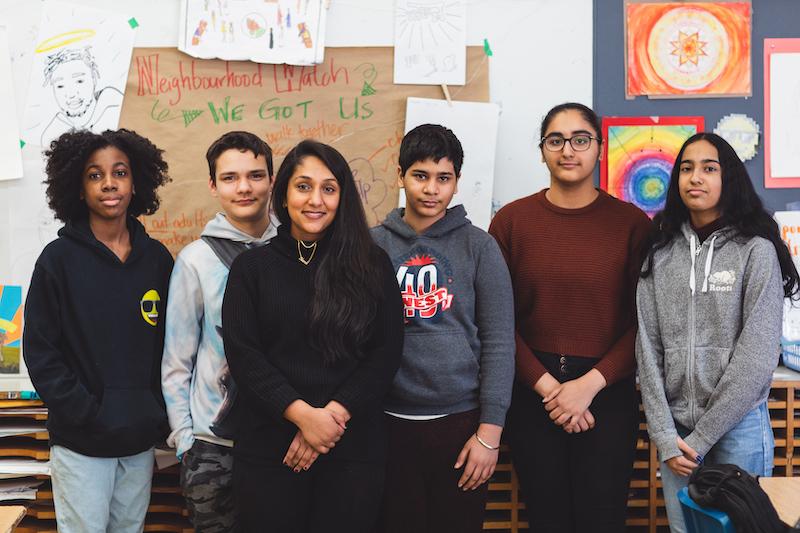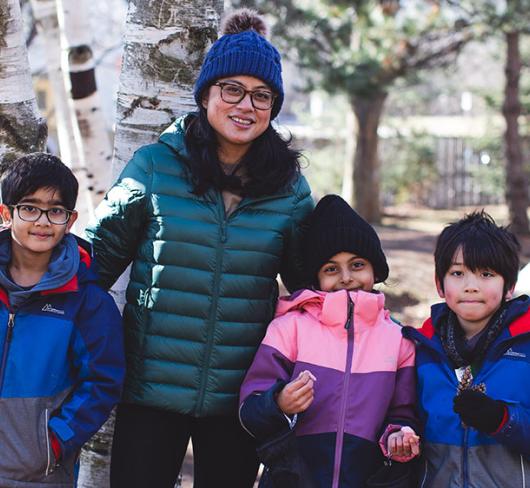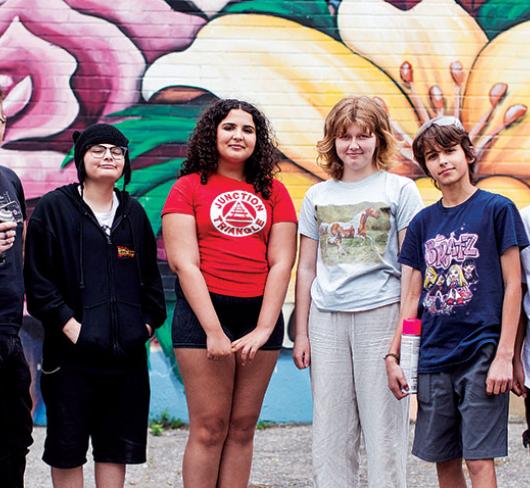
Building Cultural Agency: Creating a Community-Focused Cultural Hub
Taking field trips to art galleries is a common practice for many art teachers seeking to enrich their programming with real-life experiences. Visit local downtown galleries on a school day, and you might see teachers and students wandering through looking for inspiration from artists’ depictions of the world around them. Indeed, the arts curriculum notes that art galleries can be sites for exploring the local community and its resources. On a trip to an art gallery, however, my students and I were struck by the mismatch between what we saw on the walls and what we see in our everyday lives. Where were the high-rise buildings and basement apartments that are part of our lived experiences in the landscapes depicting Canada? Where were people who looked like us – wearing patkas, in hijab, or braided cornrows – in the portraits and photographs on the walls? Stewarding my students through these spaces, we concluded that the everyday art of our lived experiences was not reflected in the institutions that we were supposed to be learning from.
During our last art field trip, we decided to take action. If we couldn’t see more of ourselves in the art on the walls of the galleries we visited or in artists who receive mainstream acclaim, it was going to be up to us to create our own spaces and visual narratives.
Morning Star Contemporary
Morning Star Contemporary is our response to the lack of representation in mainstream institutions. It is a school-based, student-led contemporary art gallery in which the artists and art forms we learn with and from reflect the diversity of our lives. The students and I started our gallery programming in response to frustrations we have experienced as people whose identities and lived experiences are marginalized in creative narratives. Students actively intervene by using participatory action research to investigate inquiry topics based on an issue impacting their families or communities, working alongside relevant artists to share life experiences and learn new skills, creating art that offers thoughtful visions and community-inspired solutions for a more just reality, and hosting exhibitions for peers, families and neighbours to inspire one another to make a difference. These creative experiences are not only curricular learning opportunities, they are spaces for social and political solidarity and resistance.
Cultivating an understanding of reality to shape more just futures for ourselves within our school means that much of our learning happens by partnering with community members. This practice prioritizes community knowledge, wisdom and creative intuition. Since we started the gallery, we have partnered with contemporary artists whose lived experiences and creative practices reflect our own ways of experiencing the world and enrich our community. We have run workshops and displays with award-winning photographer, physician and educator Zun Lee. Together we explored how we can use photography to centre Black families’ everyday lives as worthy of artistic celebration. We have navigated difficult emotions such as loss and anger through self-directed art projects with Michèle Pearson Clarke, a Trinidadborn artist whose work in photography, film, video and installation explores grief as a queer Black person. We have taken community walks, illustrating everyday overlooked places in our neighborhood that inform our multi-hyphenated experiences as part of our explorations with Jagdeep Raina’s work. His work explores everyday Punjabi-Kashmiri experiences, looking at memory, migration and mapping our everyday landscapes. Most recently, we mounted an exhibition titled “Ancestral Futures” in which students partnered with Rajni Perera, a Sri Lankan-born, Toronto-based painter, whose own artistic journey and commitment to depicting people of colour as majestic time-travellers provided identity-affirming examples for students. We visited the artist’s show in the city and worked with them in a skill-building workshop at the school to explore how we might use our own artistic traditions to address marginalization. Students then used culturally relevant art forms to imagine futuristic artworks that depicted an ancestor/ personal hero, sharing their cultural traditions and identities as “special powers” to address a social issue. Student docents led K-8 peers through the exhibition and ran student-led artist talks for the community. Parents, caregivers and neighbours who visited beamed with pride at seeing their cultures, heritages and identities represented on gallery walls, and their thoughtful engagement with student-led conversations about topics ranging from environmental sustainability to 2SLGBTQ+ expression to mental health demonstrated how everyone in a learning community can contribute cultural wisdom to help create the future we want.
By partnering with contemporary artists whose identities and lived experiences can speak to the ways that our communities move in the world, we learn about skills, techniques and artistic approaches to creating artwork through mentorship. By locating our work away from traditional institutions and centering our artist-student partnerships and exhibitions at our school, we elevate and celebrate that communities like ours are sites for meaningful cultural production. Finally, by working in solidarity with arts educators, arts workers and community members on workshops, exhibitions and student-led panels at the gallery, we create engaging artistic experiences by and for our communities, despite social and political forces that might dictate otherwise.
Art-Making on an Increasingly Blighted Social and Political Canvas
In the spring of 2019, the provincial government made sweeping cuts to public education, eliminating vital teaching positions and gap-closing programs designed to support marginalized students. These cuts created ripple effects: for example, teaching position cuts mean that elective courses – many of which are arts courses – can no longer be offered; fewer arts opportunities are now available to our students as they progress in their public education journeys. Provincial cuts to public education and other sectors have a greater impact on communities that are already struggling. As a middle school teacher in Malton, a neighbourhood that is disproportionately impacted by opportunity gaps, I am committed to continuing to create opportunities for my students that reflect their communities and experiences and amplify their voices. In a political environment seemingly dedicated to further entrenching the very marginalization that public educators seek to ameliorate in our classrooms, creating a cultural space that unites students and the communities that support them is a powerful act of resistance.
Strategies for Creative Resistance Through the Arts
Ensure culturally relevant and responsive practices
Consider the cultural forms of expression you prioritize in arts education and how they might reify cultural and structural power. Is the art you showcase reflective of traditional Eurocentric modes of expression? How might you prioritize students’ own ways of knowing instead? When my students started to research how to tell their ancestors’ stories as part of an exhibition, we were keen to step away from traditional art forms. Instead of using traditional portraiture, students chose to integrate the embroidery practiced by many of the elders in their families to create family phulkaris. Instead of ceramic sculptures, students used materials such as West Indian shipping barrels and left-over wood for moko jumbie stilts and collaborative installations. I supported them by arranging for community elders and artists whose own cultural practices incorporate the media students were exploring to co-teach modules. There are tremendous benefits to co-constructing lessons and workshops with students based on their traditions and lived experiences.
Organize to achieve cultural justice
Create arts experiences that recognize the historical marginalization, omission and erasure of diverse cultural practices and honour students’ communities and voices. Consider how partnering with community members and artists can help centre marginalized cultural narratives to reclaim social and political power. When facilitating arts partnerships, consider not only the ways you can build powerful programming but also how your pedagogy can build solidarities between groups of people fighting for a more just way of living for all.
Show up for marginalized students by supporting them in taking up space
As holders of marginalized identities, students are often disenfranchised in creative spaces. Consider how you might work with your students to take up space by creating arts learning experiences for them, by them. On my students’ last trip to a prominent art gallery, we were keen to disrupt the knowledge flow that dictated our passive role as receivers of artistic knowledge. We arranged to run our own tour and workshop in partnership and conversation with artist Sandra Brewster, whose own work was taking up space in this institution as the first Black Canadian woman artist to have a solo show there. We discussed how we might use photography to investigate our connections to home and “back home” (our heritage homelands). Visitors gathered around our group of students and our partner artist to hear about our creative process. We took up space and took control of our artistic narratives to tell our stories.
Steward allyship by creating authentic artist/community-student learning partnerships
As culturally responsive educators, we make student and community expertise a priority in our practice because we know that when students see themselves and their communities’ knowledge reflected in their programming, it enhances learning. Are there artists and cultural producers in your city or region whose own creative practice, identity and lived experiences can authentically speak to your students? Invite them into your classroom. Powerful things can happen when community members, educators and students unite to co-construct creative experiences.
Recentre everyday community spaces as cultural hubs
Creating a school-based gallery establishes students as creative agents and storytellers. This is important in all communities, but particularly in those that are often misrepresented in the popular media. Is there a space in your school building that might be transformed into a site for creative storytelling? This space can function as a site for people to come together to engage in storytelling, acknowledging strengths and generating power and hope.
Educate for liberation
Our students absorb and are deeply impacted by the social and political conditions around them. Don’t underestimate your students’ need and capacity to unpack social and political realities; in fact, consider how using creative experiences can enhance students’ intersectional understandings of the world around them, even if these knowledges are tough to hold. By celebrating our knowledges and experiences through artistic expression and working alongside arts workers and community members to assert the value of the arts in education and community-building, all members of our learning community can come together to engage with what bell hooks calls “education as the practice of freedom.” In this sometimes challenging, but always fruitful, critical unpacking, there is creative liberation.
Neeru Sekhon is a member of the Peel Teacher Local.

